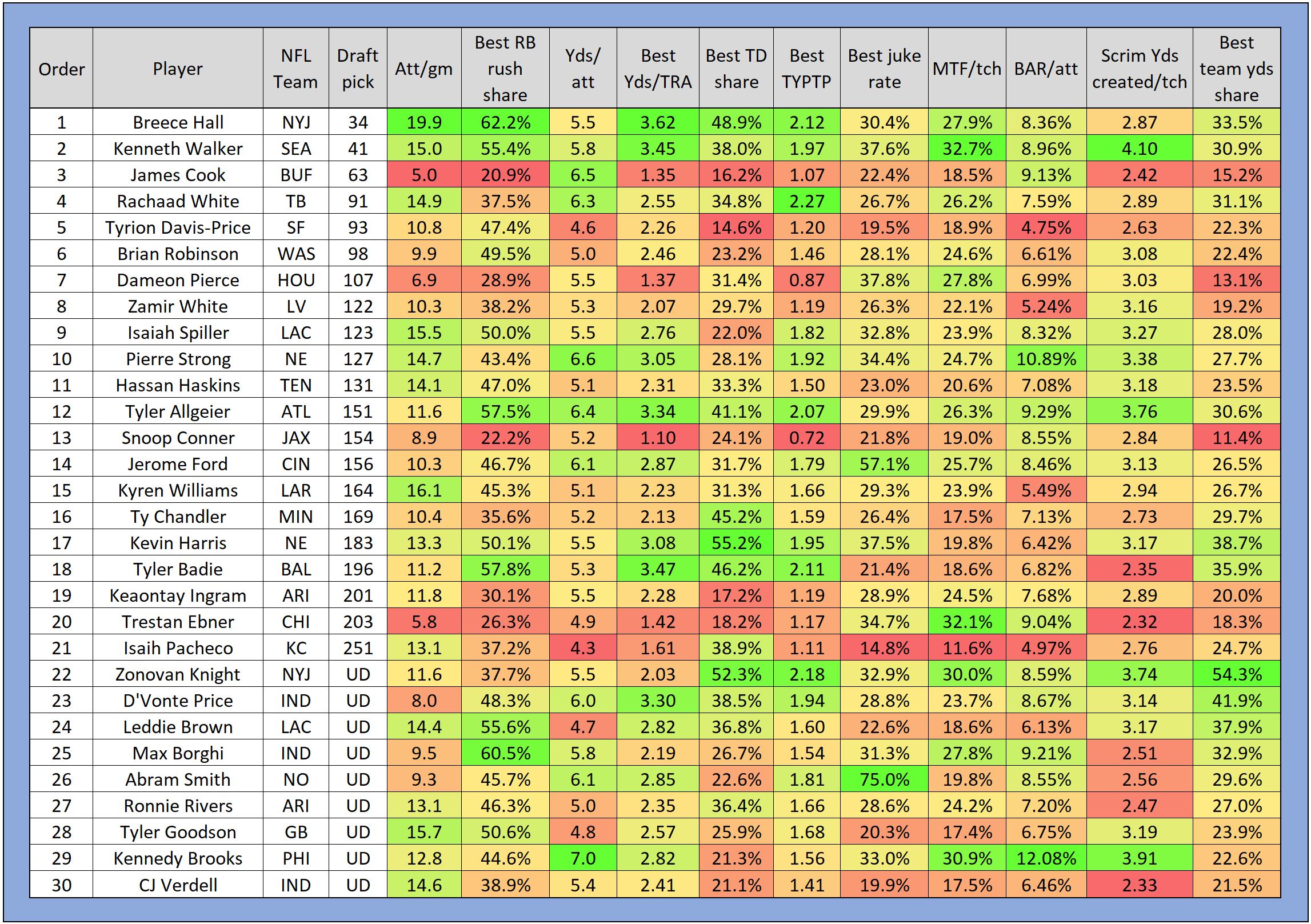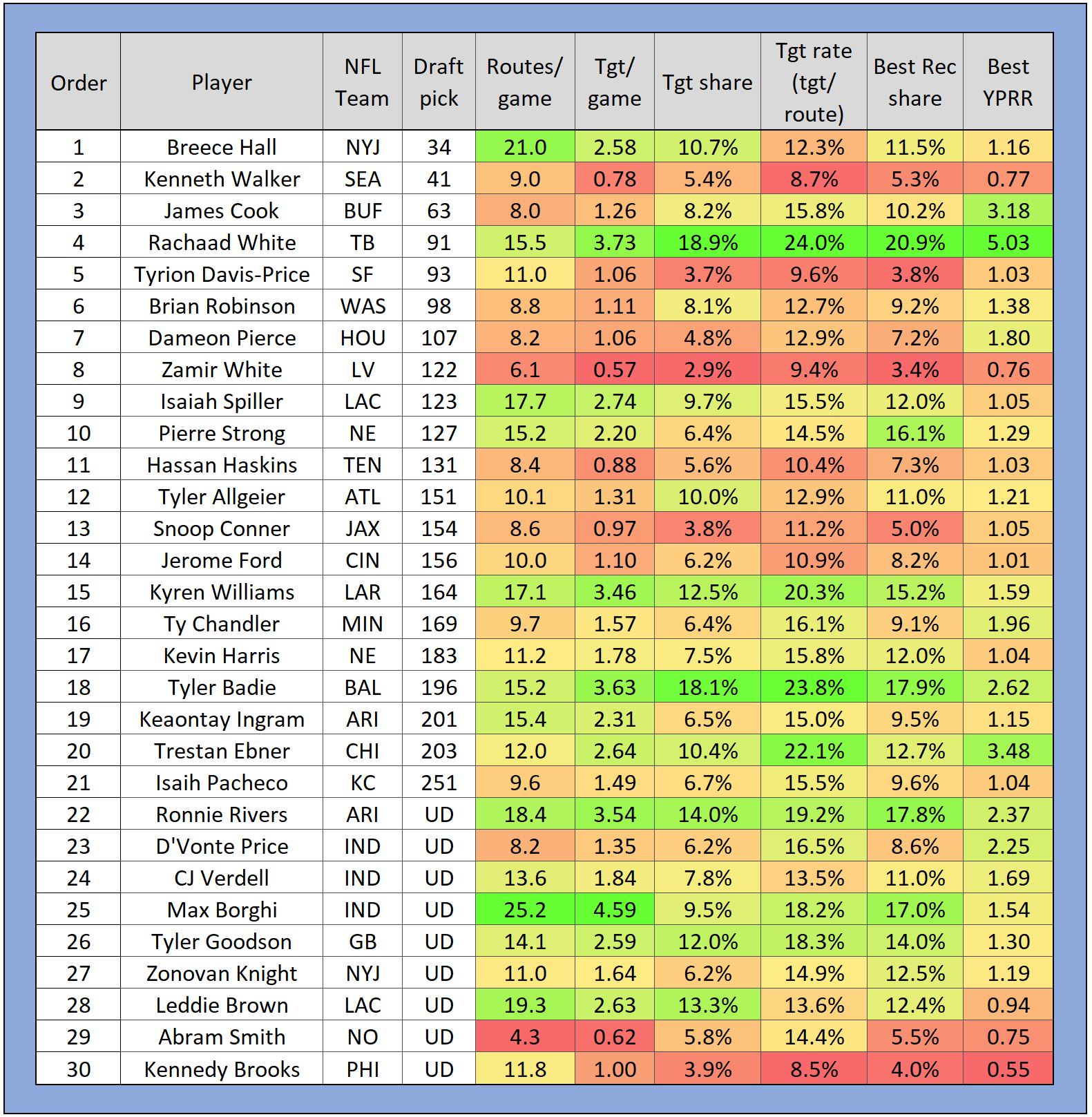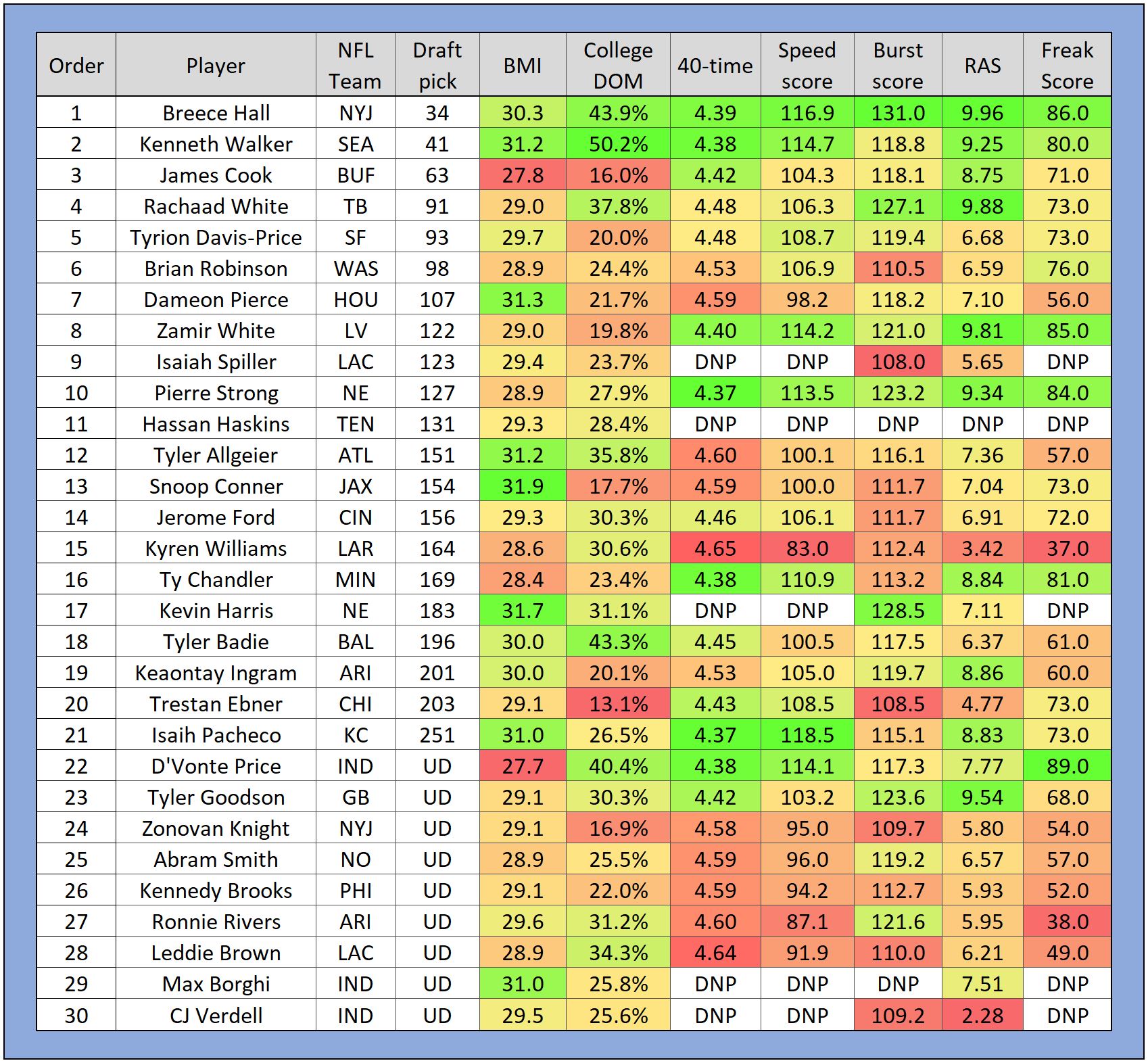Buyer Beware: A Closer Look at Bills RB James Cook
When it comes to offseason prospect analysis, diving into the incoming rookies generally falls into two phases: pre-draft and post-draft. Prior to the NFL Draft we have college production profiles and game tape, the NFL Combine and player Pro Days. Following the draft, we get to add two key pieces of information: draft capital and landing spot. As fantasy football analysts, we then utilize all of this available information to inform our decisions in our own rookie drafts in dynasty leagues and put together our best array of advice (rankings, prospect guides, rookie models, etc.) to help as many fantasy managers as possible. Staying relatively shallow for redraft formats, and delving farther down the prospect lists for dynasty, one thing is certain when it comes to rookie analysis. Most everyone is different. There are so many different angles to approach from, different values assigned to different metrics. Some assign more value to landing spot than others. Some weigh athletic metrics more heavily, others plant their flags with the analytics. Typically, it is some combination of all of this, but the pie is divided up using many different proportions.
In this article, I am going to look closer at one specific prospect, rookie RB James Cook with the Buffalo Bills. I will present the positives and negatives I see now that we have all the above-mentioned information in place. The regular season is still months away, and obviously, things can still change with trades and free-agent signings, but as it stands right now the Bills will enter the 2022 season with three noteworthy RBs: Devin Singletary, James Cook, and Zack Moss.
PROSPECT PROFILE
The Bills selected James Cook in the 2nd round with the 63rd overall pick in the 2022 NFL Draft. Cook played all four college years for the University of Georgia. Cook was the 3rd RB selected in the draft, following Breece Hall (pick 36) by the New York Jets and Kenneth Walker (pick 41) by the Seattle Seahawks. Based on general pre-draft rankings, Cook being the third RB selected was somewhat of a surprise, as many rankings had Cook’s Georgia teammate, Zamir White, and Texas A&M’s Isaiah Spiller going ahead of him, and in some cases Arizona State’s Rachaad White as well.
And like the Rachaad White, Cook did not do a whole lot at Georgia until his senior season. From 2018 to 2020, here were Cook’s per season numbers on the surface:
- 39 rush attempts, 258 rushing yards, 6.62 yards per carry, just over two rushing touchdowns
- 13 receptions, 149 receiving yards, 9.31 yards per reception, 0.67 receiving touchdowns
There is one explanation for these pedestrian numbers, at least in 2018 and 2019, and his name is D’Andre Swift. The Georgia backfield mostly belonged to Swift until he left for the NFL after the 2019 season. During that time, Cook was third in line behind Swift and Zamir White. Once Swift was out of the picture, Cook’s usage and production did improve, although not much during his junior year in 2020. In 2020, Cook put up the following:
- 45 rush attempts, 303 rushing yards, three rushing touchdowns
- 16 receptions, 225 receiving yards, two receiving touchdowns
Improvement? Slightly. But Zamir White is not a pass-catcher, so when Swift and his elite pass-catching chops were gone, I would have expected a larger jump for Cook. This is the first small red flag for me with Cook.
Cook did take a more significant jump in 2021:
- 113 rush attempts, 728 rushing yards, 6.44 yards per carry, seven rushing touchdowns
- 27 receptions, 284 receiving yards, 10.52 yards per reception, four receiving touchdowns
North of 1,000 scrimmage yards and double-digit touchdowns for the first time, this statistical jump played a part in Cook climbing into the second round of the draft.
STRENGTHS
It is no secret that James Cook is the younger brother of star NFL RB, Dalvin Cook, with the Minnesota Vikings. We know James has an athletic pedigree. When given the opportunity, Cook exhibits above-average vision and patience and has been very effective as both a runner and pass-catcher. Some speculate that if given the role, he could excel at the next level as every-down RB, as he weighed in heavier than expected at the NFL Combine and should not be thought of as undersized. He is arguably the most talented pass-catching RB in the 2022 rookie class.
His 2nd round draft capital is an obvious positive and his landing spot with one of the best offenses in the league seems like a no-brainer positive as well (more on that ahead). Cook did have an excellent senior season against the toughest competition in college football in the SEC. The Bills attempted to acquire Commanders’ pass-catching RB J.D. McKissic this offseason, and that only supports the second-round investment as the obvious signal the Bills want to add RB targets to their arsenal.
THE RISKS
Let me be clear, I think Cook is a good, not great RB and I am not projecting him to be a bust in the NFL. Rather, I’ve seen Cook going in the first round of rookie drafts as the third RB off the board. I don’t necessarily disagree with him being the third RB, but he’s been going ahead of a tier of WRs I would rather have (Skyy Moore, George Pickens, Jahan Dotson, and Christian Watson). If Cook does take on a large role in the NFL it’s entirely possible he becomes one of the steals of 2022 rookie drafts. But it is difficult to project that when he was never used in that role at Georgia. “If given the opportunity” is a common phrase when reading up on Cook’s strengths. I have also seen the “less tread on the tires” listed as a strength, but I would much rather have seen a more usage showing whether his qualitative (e.g. good vision and patience) and quantitative (e.g. 6+ yards per carry) attributes could be maintained consistently over a larger workload.
And I get it, just because a player doesn’t put up mind-boggling yardage and TD totals doesn’t mean they are not good at football. So, let’s look deeper than just yards, catches, and TDs.
As part of my preliminary process to start creating my own rookie models, I have been tracking a wide range of statistics across the skill positions. Recently, thanks to the databases made available by Peter Howard (@pahowdy on Twitter) and Dave Wright (@ff_spaceman on Twitter), I have begun doing the same for college statistics, going back as far as the available data allows. I put together three sets of data for the 2022 rookie RBs to help illustrate my concerns for the higher end of the extreme in valuing James Cook.
For each of these data sets, I included 21 of the 24 rookie RBs who were drafted and nine RBs who signed as undrafted free agents (UDFA) but were all included in the majority of pre-draft top 30 RB rankings. The reason I did not include all 24 drafted RBs was due to lack of complete information available for three of them. Each table is sorted by draft capital, with the UDFA’s in somewhat random order at the bottom.
Data for the following tables is from playerprofiler.com and the prospect database created by Dave Wright.
The first table shows rushing-related statistics:
- Rushing attempts per game (career)
- RB rush share (% of total RB attempts) (best season)
- Yards/attempt (career)
- Rushing yards per team rush attempt (Yds/TRA) (best season)
- TD share (% of team’s total TDs) (best season)
- Total yards per team play (TYPTP) (best season)
- Juke rate (best season)
- Missed tackles forced per touch (MTF/tch) (career)
- Break-away runs (20+yards) per attempt (BAR/att) (career)
- Yards created per touch (career)
- Team yards share (% of team’s total yards) (best season)
You can see Cook’s rank associated with these numbers here (among these 30 RBs):
It isn’t surprising Cook ranks low in most of these statistics. He was not a three-down back in college. He is known much more for his skills as a receiver and versatility to be able to effectively rush the ball when called upon. But that is also why I don’t get some of the hype for him in the NFL as a potential workhorse when he was never close to that in college. My thinking is simply that if he’s good enough to take on that kind of role in the NFL, he would have been given more opportunity in college, for a Georgia team that was in the National Title hunt every second of every game.
Cook does have that potential though. I am not discrediting his potential, supported here by his top 5 numbers in yards per attempt and break-away runs per touch. BAR has been shown to be a relatively predictive statistic. But being so low in so many other of these statistics, especially juke rate, missed tackles forced, and yards created, diminishes the odds of that happening at the NFL level.
Now let’s look at some receiving-related numbers:
- Routes per game (career)
- Targets per game (career)
- Target share (career)
- Target rate (targets per route run) (career)
- Reception share (best season)
- Yards per route run (best season)
Here is where Cook ranks according to these numbers:
This is obviously better than his advanced rushing numbers, but still not what I would expect to see for a player with so much hype as a pass-catching RB. Once again, he did very well in one predictive statistic (yards per route run). But maxing out at 27 catches in his best season combined with these middle-of-the-pack receiving stats makes him turning into an elite pass-catching RB in the NFL less likely.
The last table includes athletic profile-related metrics:
- BMI
- College Dominator Rating
- 40-time
- Speed Score
- Burst Score
- Relative Athletic Score
- Freak Score (courtesy of Rotoviz.com)
You can see the hit and miss nature of these metrics with the ranks:
A good 40-time and RAS again show Cook’s athleticism and potential based on that, but all together even these statistics don’t necessarily project to an upper-echelon RB in the NFL. One detail that jumped out at me with this data set was just looking at the two Georgia RBs, with Cook topping White in only one category, draft capital:
The last thing I want to look at is Cook’s landing spot. I said it earlier about Cook as a prospect. I like Cook, I think he is a talented RB who will have success in the NFL. I’m just not as high on him as most. It is the same with his landing spot. The Bills offense is one of the best landing spots for an offensive skill position player regardless of context. But I don’t see it as the slam dunk most seem to, at least not right away. The main reason for this is how the offense has operated in the three seasons since Josh Allen’s rookie year. The Bills have been a bottom three team (on average) in targeting RBs.
Part of the reason I’m lower on James Cook. Below is % targets to the skill positions over last 3 years (sorted by %tgt to RBs).
Bills have been bottom 3 in targeting RBs, which is Cook’s selling point. That may change now that they’ve drafted Cook, but that’s been the trend pic.twitter.com/TsVipOUsXS
— Scott Rinear (@MunderDifflinFF) May 6, 2022
The fact that they haven’t had a good pass-catching RB is a valid counterpoint, but I don’t think it’s that simple. It’s not something that happens overnight. Josh Allen has ranked 7th, 9th, and 6th the last three seasons, respectively, in intended air yards per pass attempt, also known as QB aDOT. If the Bills do focus their efforts on getting more targets to the RB position, I think moving up from ranking 29th in RB targets for three straight seasons is going to be a gradual climb, limiting Cook’s upside in year one.
CONCLUSION
It may seem like I’m very low on James Cook, but I promise you I am not. The purpose of this article is to show you my reasoning as to why I’m lower than consensus. James Cook is a talented, versatile, athletic RB coming out of the SEC with another stud NFL RB in his immediate family. While not the ideal size to be a workhorse in the NFL, his size doesn’t have much influence on my line of thought at all. I still think he is a top 5 rookie RB in this class. It may seem like a lot of work and a whole lot of data just to convey why I have him only a few spots lower than most, and it was, but I am always trying to look at things from as many angles as possible.
The most current Dynasty League Football (DLF) rookie draft ADP info has James Cook as the last pick of the first round (12-team). That should be his ceiling ADP, but I have seen him selected earlier in the first round ahead of some WRs I would rather have which is where my disagreement surfaces.
For me, if I’m rolling the dice on a dynamic pass-catching RB who could have an immediate fantasy impact in that role, but also has a higher likelihood of turning into a three-down back that could turn into one of the steals of 2022 rookie drafts, I’d rather go with Tampa Bay Buccaneer’s new rookie, Rachaad White (take a moment and look at Rachaad in the tables above).
Win Your Fantasy League!
Become a member at FantasyData and get access to the industry’s best fantasy football subscription available!







